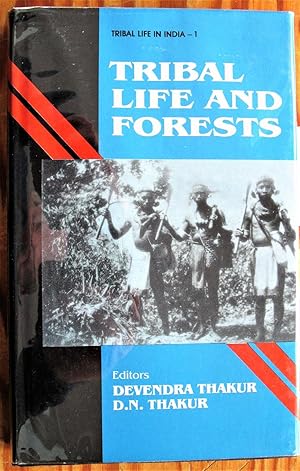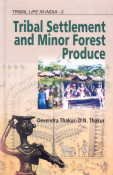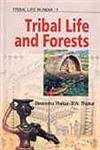D N THAKUR,DEVENDRA THAKUR (14 resultados)
Tipo de artículo
- Todo tipo de artículos
- Libros (14)
- Revistas y publicaciones
- Cómics
- Partituras
- Arte, grabados y pósters
- Fotografías
- Mapas
-
Manuscritos y
coleccionismo de papel
Condición
- Todo
- Nuevos
- Antiguos o usados
Encuadernación
- Todo
- Tapa dura
- Tapa blanda
Más atributos
- Primera edición (1)
- Firmado
- Sobrecubierta (1)
- Con imágenes del vendedor (1)
- Sin impresión bajo demanda
Ubicación del vendedor
Valoración de los vendedores
-
Tribal Life and Forests. Tribal Life in India-1.
Publicado por Deep and Deep Publications, New Delhi, 1996
Librería: Ken Jackson, Calgary, AB, Canada
Libro Original o primera edición
Hardcover. Condición: Very Good. Estado de la sobrecubierta: Very Good. 1st Edition. First edition hardcover in dust jacket. 367 pp. Tables, appendix, index. Publishers flaw has some nicks on front edge, jacket is price clipped. Very Good/Very Good.
-
Tribal Life in India : Vol: 6: Tribal Women
Publicado por Deep and Deep, New Delhi, 2009
Librería: Vedams eBooks (P) Ltd, New Delhi, India
Hardbound. Condición: As New. Reprint. Contents Preface. 1. Introduction. 2. Tribal women in perspective. 3. The planning process and tribal women. 4. Women workforce in tribal economy. 5. Tribal women in Tamil Nadu. 6. Tribal women in Andhra Pradesh. 7. Tribal women of Jaunsar Bawar. Appendix. Bibliography. Index. Little attention has been given to the understanding of millions of women dwelling in the villages and tribal areas silently carrying out traditional domestic and agricultural tasks and unquestioningly adhering to norms that have been espoused for them for many generations. We have to understand these village and tribal women make them aware of themselves and improve their lot. The tribal women have particularly played a dominant role in not only in agricultural operations but also in the field of crafts and forest based economy. In this way in the socio economic sphere the tribal women have an important position more or less equal to that of men. In spite of all the women welfare programmes benefits have not reached the tribal women. It seems to be essential to save them from exploitation to enrich their social status and to achieve their glory as respected citizens of India. In this book editors have furnished sufficient and in depth studies regarding tribal women in India. 214 pp.
-
Tribal Life in India : Vol: 7: Tribal Law and Administration
Publicado por Deep and Deep, New Delhi, 2009
Librería: Vedams eBooks (P) Ltd, New Delhi, India
Hardbound. Condición: As New. Reprint. Contents Preface. 1. Introduction. 2. Constitution of India relevant to the Scheduled Tribes. 3. Legislation of general nature extended to the scheduled areas. 4. Articles of the constitution relevant to the Scheduled Tribes. 5. Legislative powers about tribal affairs. 6. The tribal problem and protective measures. 7. Administration of tribal areas. 8. Administration for tribal development. Appendices. Index. The framers of Indian Constitution keeping in view the socio economic backwardness of the tribals provided special status for their development in independent India. Gradually many laws have been passed and a separate administrative system has been created in order to bring the tribals in the main stream of our ideal democratic system. This book on tribal law and administration comprises not only the constitutional safeguards and privileges accorded to the tribals but also other legal aspects relating to them. It also includes constitutional amendments and a summary of laws passed by various states to protect the rights of tribals on land. Similarly tribal administration has also been presented in historical perspective which starts from the administration of the tribal areas in the British regime. 258 pp.
-
Tribal Life in India : Vol: 10: Role of Voluntary Organisations in Tribal Development
Publicado por Deep and Deep, New Delhi, 2009
Librería: Vedams eBooks (P) Ltd, New Delhi, India
Hardbound. Condición: As New. Reprint. Contents Preface. 1. Tribes in India. 2. Socio economic change of tribes by government and voluntary agencies. 3. Socio economic condition of Santhal Tribes. 4. Voluntary agencies for development of Scheduled Castes and Scheduled Tribes their role and function. 5. Role of government in tribal development and social change. 6. Voluntary organisations and tribal development a case study. 7. Present comparative picture. 8. Conclusion and recommendations. Appendices. Bibliography. Index. During post independence period through planning process special efforts have been made by the government to bring about economic development of tribal people. But inspite of special efforts made during four decades of planning tribal people have not come at par with other sections of the society. This book aims at examining the role of voluntary and governmental organisations in bringing about economic development so that a comparative view can be presented to assess their contribution. 304 pp.
-
Tribal Life in India : Vol: 1: Tribal Life and Forests
Publicado por Deep and Deep, New Delhi, 2009
Librería: Vedams eBooks (P) Ltd, New Delhi, India
Hardbound. Condición: As New. Reprint. Contents Preface. 1. Introduction tribes in India. 2. Scheduled Tribes and scheduled areas in India. 3. Tribes in South India. 4. Tribes in Central India. 5. Tribes in Eastern India. 6. Forest and tribal life. 7. Forest and tribal economy. 8. Forestry and tribal development. 9. Forests and Central Indian tribes. 10. Forest labour co operative societies in Maharashtra and Gujarat their significance in tribal development. 11. Forest economy. Appendix forest statistics. Index. Tribal people being the original inhabitants of India constitute a significant part of this vast nation. They have been dwelling in the forests surrounded by hills for a long period. Their social structure their culture and their language are quite different from the general people of India. In course of time in the post independence era a lot of changes have taken place in the tribal areas due to immense endeavours of the government for their socio economic development. But inspite of all endeavours they are still poor as well as illiterate and are far from the main stream of Indian society. This book comprises the study of tribal life and their relation to forest in historical as well as in modern perspective. 364 pp.
-
Tribal Life in India : Vol: 3: Tribal Agriculture and Animal Husbandry
Publicado por Deep and Deep, New Delhi, 2009
Librería: Vedams eBooks (P) Ltd, New Delhi, India
Hardbound. Condición: As New. Reprint. Contents Preface. 1. Introduction land and the tribe. 2. Tribal agriculture operational holdings. 3. The agriculture scenario general trends. 4. Shifting cultivation. 5. Problem of shifting cultivators. 6. Agriculture and animal husbandry. 7. New technology and agricultural development in tribal areas. 8. Problems in agricultural development in tribal areas. 9. Issues in agricultural development in a tribal area a study of Panchamahals District. 10. Tribal economic formations based upon settled agriculture and their modes of dissolution. 11. Cattle and livestock. Appendix cattle statistics. Index. India is primarily the land of agriculture and the tribal people being the original inhabitants of this land are not only closely related to agriculture but they depend almost totally on cultivation. There are a number of special and religious rituals connected with agriculture which explicitly disclose their emotional relation with land and crops in addition to plants trees and animals. In ancient times food gathering and hunting were the chief sources of the livelihood of the tribal community. But in course of time as a result of pressure of population they acquired the skill of agriculture. They cleared the forests and brought land under cultivation. They consider themselves to be the original owners of the land they cultivate. But the advanced people from outside forced them in many ways to leave the land which created serious problems and government had to make certain rules relating to the tribal ownership of land. Tribal life is chiefly based on agriculture and closely associated with animal husbandry. This book studies in depth the tribal agriculture and animal husbandry and their association with tribal life. Also studied is the introduction of new agricultural technology in the tribal areas. 370 pp.
-
Tribal Life in India : Vol: 4: Industrialisation in Tribal Areas
Publicado por Deep and Deep, New Delhi, 2009
Librería: Vedams eBooks (P) Ltd, New Delhi, India
Hardbound. Condición: As New. Reprint. Contents Preface. 1. Introduction industrialisation in tribal areas. 2. Tribal economy and industrialisation. 3. Large scale industry. 4. Cottage industry. 5. Small scale industry. 6. Industrial complexes in the tribal belts problems and prospects. 7. Industrial planning in the tribal areas. 8. Modern industry in tribal belts. Bibliography. Index. Though industrialisation in the tribal belts started in the pre independence era it took a dynamic turn only in the post independent India when heavy industries like heavy engineering at Ranchi iron and steel factories at Rourkela Bhilai Durgapur etc. were established in the tribal areas. In course of time the tribal land which was free from environmental problems is now full of industrial garbage and smoke. In spite of that the tribal people get almost nothing as a return. They are still working as unskilled labourers and have not been freed from their age long poverty and backwardness. Moreover sometimes they have to alienate from not only from their land but they have also to become homeless. This book studies the facts and figures of industrialisation in the tribal belts. It starts with the review of tribal economy in the context of industrialisation. It further deals with large small and cottage industries established in the backward regions of the tribal people. In addition to these it presents the study of industrial complexes in the tribal belts. Industrial planning in the tribal areas has also been a significant part of this work. Finally the scope of modern industry has been the subject of our observations. 348 pp.
-
Tribal Life in India : Vol: 5: Tribal Labour and Employment
Publicado por Deep and Deep, New Delhi, 2009
Librería: Vedams eBooks (P) Ltd, New Delhi, India
Hardbound. Condición: As New. Reprint. Contents Preface. 1. Tribal labour a historical review. 2. Problems of tribal labour. 3. Rehabilitation of freed bonded labourers. 4. Agricultural labour and the tribe. 5. Tribal worker in the industry. 6. Tribal women workforce. 7. Entrepreneurship in the tribal areas. 8. Rural child labour in India Its magnitude and determinants. 9. The co operative movement in tribal workers. 10. Tribal labour and employment. 11. Labour employment reservation and training. 12. Planning for full employment in tribal areas. Appendices 1. National rural employment programme. 2. The right of migrant workers. Index. The tribal societies have their own tradition of living. They manage their affairs in their own social structure. Long before they chiefly depended upon hunting and food gathering but with the pressure of population they gradually took to agriculture and started cottage industries. After independence when a lot of large industries were established in the tribal areas they also got opportunities to work in them as unskilled laborers. But inspite of immense efforts of the government the benefits of economic development have not properly reached the tribal people. This book deals with the problems of tribal workers and tries to search opportunities for their employment in different fields. It studies tribal labour and planning for their full employment. 396 pp.
-
Tribal Life in India : Vol: 8: Tribal Education
Publicado por Deep and Deep, New Delhi, 2009
Librería: Vedams eBooks (P) Ltd, New Delhi, India
Hardbound. Condición: As New. Reprint. Contents Preface. Introduction. 1. Tribal education in modern India. 2. Education planning for the tribes. 3. Educational development of the tribes. 4. Primary and secondary education for the tribes. 5. University education and the tribes. 6. Problems of tribal education. 7. Job oriented education. 8. Impacts of education policy in India. Index. Education is not only a means of development but it is also an end in itself. To be more clear education leads a man from darkness to light. Explicitly if we want to bring the tribal people in light we will have to impart them proper education for their all round development. The government of India has made immense endeavour to educate the tribal people and now there is at least a primary school in every remote corner of the tribal belts. In this book the editors bring out the facts and figures relating to tribal education. The book gives a general description of tribal education. It further deals with modern Indian education in the context of the tribes and their development. The relation of tribes with primary secondary and university education constitute a significant part of this work. Finally it delineates the problems of tribal education ending with job oriented education for the tribes. 394 pp.
-
Tribal Life in India : Vol: 9: Tribal Development and Planning
Publicado por Deep and Deep, New Delhi, 2009
Librería: Vedams eBooks (P) Ltd, New Delhi, India
Hardbound. Condición: As New. Reprint. Contents Preface. 1. Introduction. 2. Planning progress and methodology. 3. Planning for tribal development. 4. Tribal people's participation in development. 5. Strategies for economic development of tribals. 6. Development measures for tribes. 7. An approach to tribal development. 8. Review of the tribal sub plan. 9. The tribal problem. 10. Problems of tribal population. Index. Economic Planning since First Five Year Plan recommended that a positive policy of assisting the tribals should be formulated in order to develop their natural resources and evolve a productive life which can prevent exploitation by more organised economic forces. In the Second Plan it was emphasised that all welfare programmes should be made in the context of tribal culture after reviewing their psychological and economic problems. In the Third Plan it was accepted in principle that in facilitating the development of agriculture communication health and education services the tribal people should be able to develop their own traditional wits and culture without pressure or imposition from outside. Under the Fourth Plan Six Pilot Projects for tribal development known as tribal development agencies were taken up in central sector. The Fifth Sixth and Seventh Plans saw the emergence of the tribal development strategy in the country on a massive scale. The tribal sub plan envisaged pooling of all available fiscal and personal resources. The Eighth Ninth and Tenth Plans emphasise a total integrated effort for all round tribal development. This book studies in depth the massive efforts that have been made for the socio economic development of the tribal people by the government through organised economic planning. For future planning for tribal development the study of the past endeavours seems to be essential. This aspect has been kept in view while preparing this book. 486 pp.
-
Tribal Life in India : Vol: 2: Tribal Settlement and Minor Forest Produce
Publicado por Deep and Deep, New Delhi, 2009
ISBN 10: 8184501056ISBN 13: 9788184501056
Librería: Vedams eBooks (P) Ltd, New Delhi, India
Libro
Hardbound. Condición: As New. Reprint. Contents Preface. I. Tribal settlement 1. Introduction. 2. Profile of tribal habitations. 3. Tribal settlement and habitation in Chatighar and Chatighar (Jarimuhan). 4. Tribal settlement and habitation in Pimpudia and Phuljhari. 5. Tribal settlement and habitation in Chhotatentuli. 6. Tribal settlement and habitation in Jamboo. 7. Tribal settlement and habitations in Badamula and Basudevpur. 8. Tribal settlement and habitations in Chungamatia Nuagaon Chargachhia and Pauri. 9. Tribal settlement and habitation in Birendhap Mandopari Tithaitangar Amatpari and Patiora. 10. Shifting cultivation. 11. Study of shifting cultivation approach and the findings. II. Minor forest produce 12. Introduction. 13. Minor forest produce. 14. Collection and processing. 15. The market. 16. Recommendations. Bibliography. Index. Tribal socio economic life and forests are co related terms without which tribal living cannot be imagined. Tribal economy is mostly hand to mouth economy. It is mainly confined to essentials viz. food shelter cloth and herbs. Its social and cultural structure and level has been framed considering forest as base. With changing times and modern development tribals settlements are threatened and the role of jungles in supplying essentials is diminishing. Endeavour should be made that the jungle based economy of the tribals are not made zero in near future. This book studies the two major aspects i.e. of tribal settlement in reserve forest areas and minor forest produce. 506 pp.
-
Role of Voluntary Organisations in Tribal Development
Publicado por Balaji World of Books, 2009
ISBN 10: 8184501137ISBN 13: 9788184501131
Librería: dsmbooks, Liverpool, Reino Unido
Libro
Hardcover. Condición: Like New. Like New. book.
-
Tribal Life and Forests
Publicado por Balaji World of Books, 2009
ISBN 10: 8184501048ISBN 13: 9788184501049
Librería: dsmbooks, Liverpool, Reino Unido
Libro
Hardcover. Condición: Like New. Like New. book.
-
Industrialisation in Tribal Areas
Publicado por Deep & Deep Publications, 2009
ISBN 10: 8184501072ISBN 13: 9788184501070
Librería: dsmbooks, Liverpool, Reino Unido
Libro
Hardcover. Condición: Like New. Like New. book.







